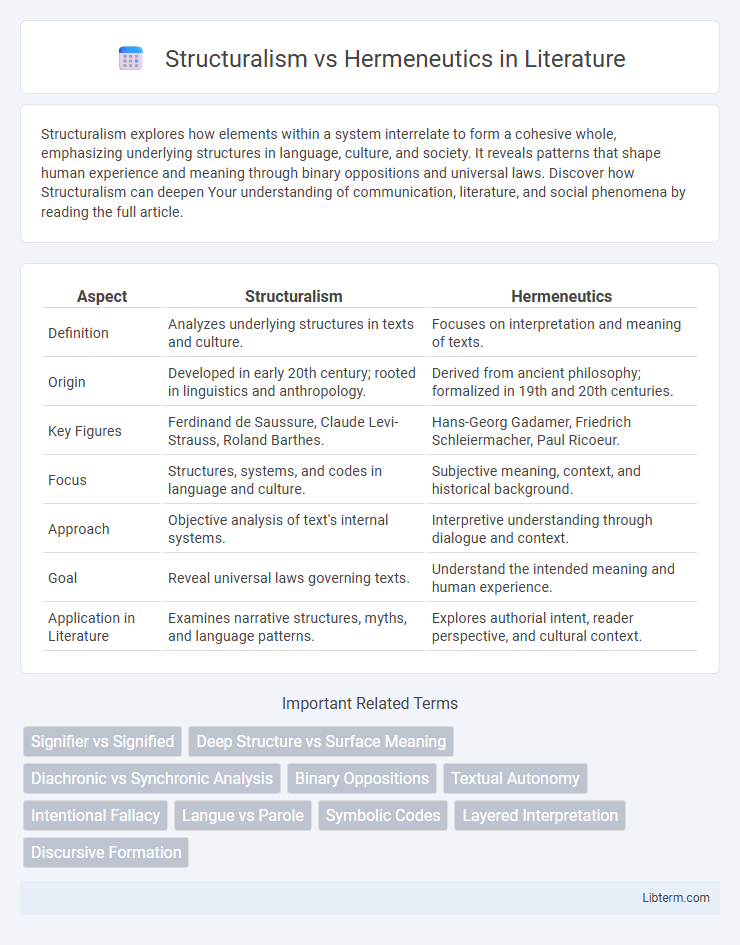Structuralism explores how elements within a system interrelate to form a cohesive whole, emphasizing underlying structures in language, culture, and society. It reveals patterns that shape human experience and meaning through binary oppositions and universal laws. Discover how Structuralism can deepen Your understanding of communication, literature, and social phenomena by reading the full article.
Table of Comparison
| Aspect | Structuralism | Hermeneutics |
|---|---|---|
| Definition | Analyzes underlying structures in texts and culture. | Focuses on interpretation and meaning of texts. |
| Origin | Developed in early 20th century; rooted in linguistics and anthropology. | Derived from ancient philosophy; formalized in 19th and 20th centuries. |
| Key Figures | Ferdinand de Saussure, Claude Levi-Strauss, Roland Barthes. | Hans-Georg Gadamer, Friedrich Schleiermacher, Paul Ricoeur. |
| Focus | Structures, systems, and codes in language and culture. | Subjective meaning, context, and historical background. |
| Approach | Objective analysis of text's internal systems. | Interpretive understanding through dialogue and context. |
| Goal | Reveal universal laws governing texts. | Understand the intended meaning and human experience. |
| Application in Literature | Examines narrative structures, myths, and language patterns. | Explores authorial intent, reader perspective, and cultural context. |
Introduction to Structuralism and Hermeneutics
Structuralism emphasizes analyzing cultural phenomena through underlying structures such as language, myths, and social systems, seeking patterns that govern human behavior and meaning. Hermeneutics focuses on interpreting texts and human experiences by understanding context, intention, and historical background to uncover deeper meanings. Structuralism employs systematic, scientific methods, while hermeneutics prioritizes subjective interpretation and the dynamic interaction between reader and text.
Historical Development of Both Theories
Structuralism emerged in the early 20th century, rooted in linguistics with Ferdinand de Saussure's theory of signs, emphasizing underlying systems and structures that govern cultural phenomena. Hermeneutics, with origins in ancient philosophy and theological exegesis, evolved significantly in the 19th and 20th centuries through thinkers like Wilhelm Dilthey and Hans-Georg Gadamer, focusing on interpretative understanding and the context of human experience. The historical development of both theories highlights Structuralism's analytical approach to deep structures and Hermeneutics' emphasis on meaning and historical context within human sciences.
Key Concepts in Structuralism
Structuralism centers on the idea that elements of human culture must be understood through their relationships within a larger, overarching system or structure. Key concepts include binary oppositions, underlying codes, and deep structures that shape meanings beyond individual elements. This approach contrasts with Hermeneutics, which emphasizes interpretation and the subjective understanding of texts or behaviors.
Fundamental Principles of Hermeneutics
Hermeneutics centers on interpreting meaning through understanding context, intention, and the historical background of texts, emphasizing the fusion of horizons between the interpreter and the source material. It contrasts with Structuralism, which analyzes underlying systems and structures detached from authorial intent or cultural context. Fundamental principles of hermeneutics include the hermeneutic circle, where understanding the whole and its parts is interdependent, and the emphasis on empathy and dialogical engagement with texts.
Major Thinkers: Saussure vs. Gadamer
Ferdinand de Saussure, the father of Structuralism, emphasized language as a system of signs where meaning arises from differences within the structure rather than individual elements. Hans-Georg Gadamer, a leading figure in Hermeneutics, focused on the interpretative process, arguing that understanding is shaped by historical context and the interplay between the text and the interpreter. Saussure's approach prioritizes underlying linguistic structures, while Gadamer highlights the dynamic fusion of horizons in meaning-making.
Methodological Differences: Analysis vs. Interpretation
Structuralism emphasizes a methodological approach based on systematic analysis, deconstructing texts or cultural phenomena into underlying structures and patterns to uncover universal principles. Hermeneutics prioritizes interpretative methods, focusing on understanding meaning within historical, cultural, and contextual frameworks by engaging deeply with the subjective intentions and experiences of authors or subjects. While structuralism seeks objective rules through binary oppositions and synchronic analysis, hermeneutics employs a diachronic, dialogical process to reveal the evolving significance and nuanced interpretations of texts.
Applications in Literary and Cultural Studies
Structuralism in literary and cultural studies emphasizes analyzing underlying systems such as language, myths, and narratives to uncover universal patterns and structures shaping texts and cultural artifacts. Hermeneutics focuses on interpreting meaning through contextual understanding, historical background, and the relationship between the author, text, and reader, enabling more nuanced readings of culture and literature. Applications of structuralism highlight patterns and binaries within texts, while hermeneutics deepens insight into subjective experiences and cultural significance.
Criticisms of Structuralism
Structuralism faces criticism for its deterministic approach, which often overlooks individual agency and historical context in interpreting human behavior and culture. Critics argue that its rigid focus on underlying structures neglects the fluidity and subjective experience emphasized in hermeneutics. This reductionist tendency limits understanding by ignoring the meanings and intentions behind social phenomena, a key concern in hermeneutic analysis.
Debates Surrounding Hermeneutics
Hermeneutics debates center on the interpretative process and the role of the human subject in meaning-making, contrasting with Structuralism's emphasis on underlying linguistic and cultural systems. Critics of hermeneutics argue that it risks subjective bias and relativism, while proponents assert its necessity for understanding texts within historical and social contexts. Key figures like Hans-Georg Gadamer highlight the fusion of horizons, emphasizing dialogue between interpreter and text to reveal deeper truths.
Structuralism and Hermeneutics: Contemporary Relevance
Structuralism, with its focus on underlying systems and language structures, remains foundational in fields like linguistics, anthropology, and literary theory, influencing contemporary methods for analyzing cultural phenomena and texts. Hermeneutics, emphasizing interpretation and the subjective understanding of meaning, retains crucial relevance in philosophy, theology, and social sciences by addressing the complexities of human experience and communication. Both approaches contribute complementary perspectives: Structuralism provides a systematic framework for uncovering hidden patterns, while Hermeneutics enriches interpretation through contextual and historical awareness.
Structuralism Infographic

 libterm.com
libterm.com